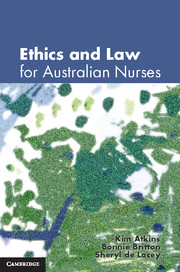Book contents
- Frontmatter
- Contents
- Introduction
- 1 Understanding the human person
- 2 Understanding legal rights and obligations
- 3 Nursing and the legal system
- 4 The nurse–patient relationship
- 5 Consent
- 6 Duty of care and professional negligence
- 7 Patient information, confidentiality and trust
- 8 ‘Trust me, I’m a nurse’
- 9 Witnessing and making mistakes
- Appendix: Tables of legislation
- References
- Index
- References
3 - Nursing and the legal system
- Frontmatter
- Contents
- Introduction
- 1 Understanding the human person
- 2 Understanding legal rights and obligations
- 3 Nursing and the legal system
- 4 The nurse–patient relationship
- 5 Consent
- 6 Duty of care and professional negligence
- 7 Patient information, confidentiality and trust
- 8 ‘Trust me, I’m a nurse’
- 9 Witnessing and making mistakes
- Appendix: Tables of legislation
- References
- Index
- References
Summary
LEARNING OBJECTIVES
In this chapter, you will:
Distinguish between the two sources of law in Australia: statutory law and common law
Learn about the process of enacting statutes
Understand the hierarchy of the courts in Australia's legal system
Distinguish between different branches of Australia's legal system
Understand the difference between criminal and civil law and how each relates to the health professional
Understand the importance for nurses of gaining knowledge of the law and the legal system
The Australian legal system is complex. An illustration of its complexity can be seen in the case of Dr Jayant Patel, a surgeon who had been working at the Bundaberg Base Hospital. In 2010, Patel was found to have caused the death of three patients and the grievous bodily harm of another. An action of criminal negligence was brought against Dr Patel under section 288 of the Criminal Code Act 1899 (Qld). Jurors were advised that, in order to find Dr Patel guilty, they had to find that his decision to perform the operations showed such ‘serious disregard for the patients’ welfare that he should be punished as a criminal’ – or, in other words, ‘that his decision to operate was so thoroughly reprehensible, involving such grave moral guilt, that it should be treated as a crime deserving punishment’ (The Australian, 23 June 2010).
- Type
- Chapter
- Information
- Ethics and Law for Australian Nurses , pp. 56 - 77Publisher: Cambridge University PressPrint publication year: 2011

